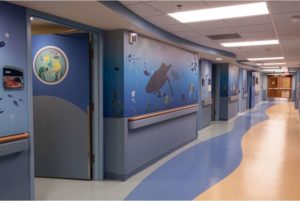The Imaginative, Arresting and Comforting Power of Graphics
Have you ever wandered through an office building searching for a coffee bar, a boardroom, or a bathroom, pleading in desperation for a sign from above, on a wall, anywhere? Then you know firsthand the value of graphics that artfully usher people to their seats.
In short, graphics in the form of wayfinding signs deliver us to a destination. But ask anyone at Image360 and they will tell you that graphics can also convey a message well beyond where to go and how to get there.

It’s based on a fundamental principle that compelling communications is equal parts what we say and how we say it. It’s not just text or an arrow that points our way, but graphics that orient, inform, educate, delight and reach deeper. Without our even acknowledging it, graphics can put a bounce in our step, a smile on our face, and a good feeling about a brand, a product, or a company we’d like to do business with.
It’s a creative and commercial discipline known as experiential graphic design, where content is infused with elements of typography, color, imagery, form and technology to create environments that more effectively communicate. Taken together those components can push more sensory buttons than you might imagine: sight, sound, smell, taste and touch.
“We’re creating spaces that communicate,” says Scott Kozaruk, Director of Experiential Graphic Design for Alliance Franchise Brands. “And, we’re changing the way people experience products, places and environments.” Scott champions how our franchise members are reshaping the end-user experience by providing our B2B clients with a one-stop resource for technologically advanced and strategically sound, graphic-communication solutions.
Scott is known admiringly around the Home-Office and across the Alliance Franchise Brands network as The Art Guy for his flair and ingenuity—his art of creativity and his art of installation. He has more than 30-years experience perfecting his trademark skill for creating spaces that communicate.
“Every environment can be enhanced by experiential design,” says Scott. “Even though there’s a lot to see and very little time for pedestrians to read as they walk through a space, wayfinding is more than a sign that points a direction or says turn right. When people are on a mission, experiential designs can aid in their thought process and journey.
“When I meet with members I tell them to recommend solutions as opposed to just executing signs. I help them create the message. I talk to them about how graphics have to be relevant and in the round because all different types of people are going to be acting on them.
“I recently went with a member to help make a sale. In my research on the company, their building was a million square feet, with only mail stops and room designations, and no wayfinding program. I told the potential client that we could enhance their signage with our experiential design expertise and also create a wayfinding system to move their 3,000 people. They paid us to submit a proposal and are reviewing our 4,800-sign recommendation.”
Our center owners across the U.S. and into Canada are embracing experiential design as a competitive advantage. When they’re out strengthening relationships with existing clients and exploring new business opportunities, they know that producing graphics is one thing, but understanding the essence of the client’s brand and integrating it into their space is really what it’s all about.
